
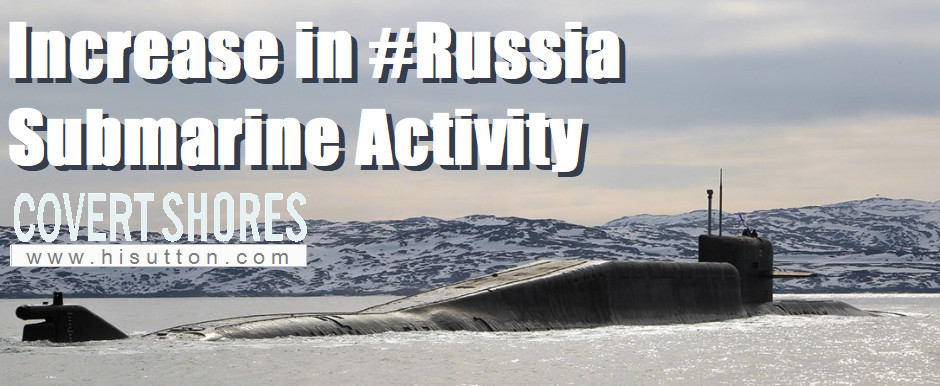
Sanity checking reports of increased Russian submarine activity
 There have been reports that Russian submarine activity has returned to Cold War levels. This article uses publicly available data to compare recent activity to Cold War levels.
There have been reports that Russian submarine activity has returned to Cold War levels. This article uses publicly available data to compare recent activity to Cold War levels.
Executive Summary
- Russian submarine activity is indeed increasing. Although total at-sea days are fewer than during the Cold War, the at-sea days per submarine has returned to similar levels.
- The main measure of activity levels is at-sea days. The most recent figures, for 2016, work out at 52 days per submarine. This compares to a low of ~56 days in 1976, and a high of ~76 days in 1980.
- The Russian ballistic missile submarine (SSBN) fleet appears to have returned to a continuous at-sea deterrent (CASD) status. This is supported by analysis of commercial satellite imagery.
- According to Russian reports, their submarines are being operated more assertively
Analysis
The reports have been circulating for several years. In February 2016 Vice-Admiral Clive Johnstone, Commander of NATO’s Maritime Command, told IHS Jane’s that NATO sees “more activity from Russian submarines than we’ve seen since the days of the Cold War”. The point was reiterated by NATO Secretary-general Jens Stoltenberg in December 2017 (Politico.eu). The theme has been repeated several times in Western media.
The gist of these statements is not contradicted by Russian sources. In spring 2017 the Commander in Chief of the Russian Navy, Admiral Vladimir Korolev stated that Russian submarines spent 3,000 days at sea on active service in 2016 (Sky News).
The Russian submarine force is also being more assertive, in the manner of Cold War norms: in March 2018 Russian media reported that a Russian submarine from the Northern Fleet (likely an AKULA Class SSN) had tracked an unspecified NATO submarine for several days without being counter-detected (ref. The Independent Barents Observer). The same reports included claims that another Russian submarine had ventured to the East Coast of the United States where it apparently sailed unnoticed, close to a US military base which could possibly have been New London, Norfolk or Kings Bay. These Russian media reports were quickly removed when they caught the eye of Western observers.
Periscope images also emerged on Twitter showing a US Navy Carrier Battle Group, apparently taken by an OSCAR-II SSGN in the Mediterranean in 2016:
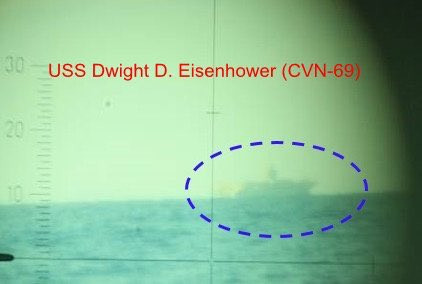
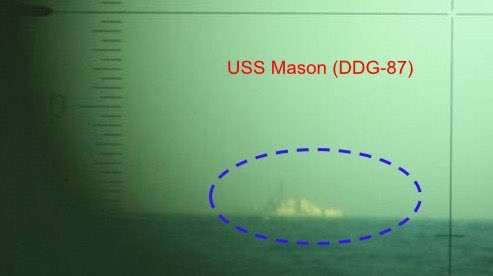
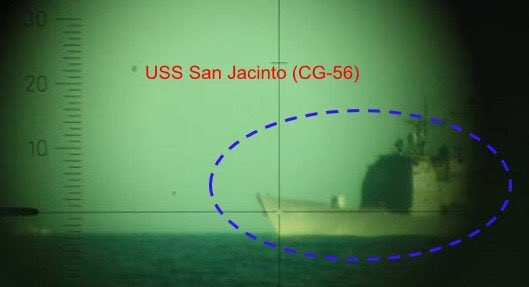
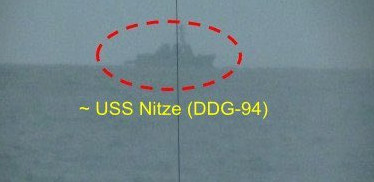
Get The essential guide to World Submarines
This Covert Shores Recognition Guide Covers over 80 classes of submarines including all types currently in service with World Navies.Check it out on Amazon
At-Sea days
The main measure of submarine activity is at-sea days, meaning the time spent by a submarine on active operations. In general, the more at-sea days a submarine’s crew gets, the higher their combat readiness.
At face value however, 3,000 at-sea days is far short of Cold War numbers however, when Soviet (now Russian) submarines were spending up to 17,000 days at sea per year beyond home waters. These numbers need context however. This article attempts to put these claims into context and make a meaningful comparison to Cold War submarine activity using Open Sources (OSINT).
Russia operates 58 submarines (excluding Special Mission midget submarines), so the average submarine spent 52 days at sea in 2016.
Note that some submarines were in maintenance or awaiting modernization for some or all of this time – I have left them in the count to make comparisons with Cold War data like-for-like
What were Cold War Levels?
During the ‘70s & ‘80s Soviet submarine forces spent between 10,000 and 18,000 at-sea days outside home waters, with approximately a 2:1 ratio of attack submarine days to ballistic missile submarine days (example source: CIA archives). This was considerably more time than the more visible surface combatant fleet which clocked up about 7,000 at-sea days per year outside home waters. The low for submarine forces was in 1976, with highs in 1980 and 1984. At times up to 10 Soviet submarines were operating in the Atlantic alone (CIA archives).
CIA report of At-Sea days during 1984. CLICK for HIGH RESOLUTION:
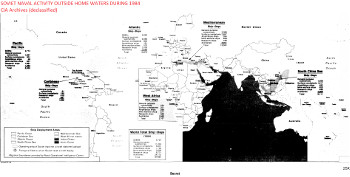
It is important to consider that these figures are beyond home waters. Russia has four fleets, each with an area of sea which can be considered ‘home waters’ from the perspective of Russia (i.e. the whole Baltic is ‘home’ to the Baltic Fleet):
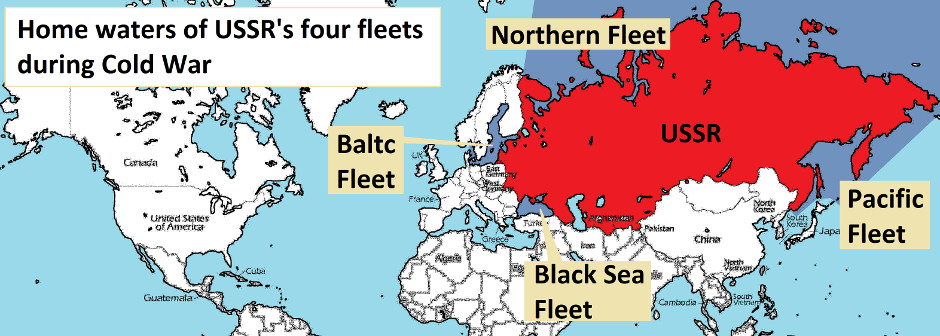
Accordingly, I have added 20% to the At-Sea days to account for transit and training in home waters. In my calculations I have also excluded classes of submarine which would not be expected to leave home waters (in the current Russian Navy all classes are long ranged and/or forward deployed). This provides a like-for-like comparison with the latest figures from Admiral Vladimir Korolev.
In 1976, a low-point in Soviet submarine activity, they had ~434 submarines in service. Many of these were types which would only rarely venture beyond home waters, so an adjusted figure is 237 boats. Therefore, the average submarine spent about 46 days at sea beyond home waters. Adjusted for home water operations, this equates to ~56 days per boat.
Breaking it down by the CIA’s category of submarine, we find the SSBNs achieved on average 64 days, and General-Purpose submarines (SSGNs, SSNs, SS) averaged 53 days. This implies two patrols of about one month for the typical boat.
Note that some submarines within a force may be inactive at any point in time due to maintenance etc.
In 1980, the high-point, relevant Russian submarines would have averaged 76 days at-sea, with 84 days for SSBNs and 73 days for GP boats.
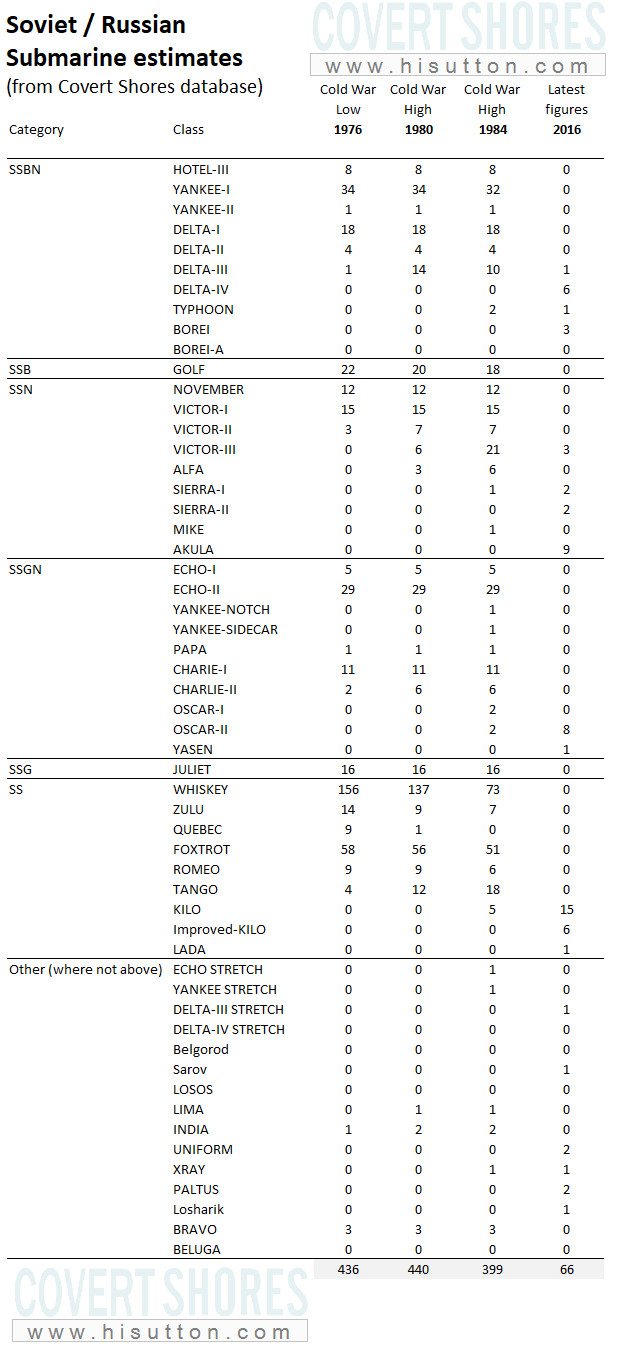
THE book on Special Forces subs Covert Shores 2nd Edition. A world history of naval Special Forces, their missions and their specialist vehicles. SEALs, SBS, COMSUBIN, Sh-13, Spetsnaz, Kampfschwimmers, Commando Hubert, 4RR and many more.
Check it out on Amazon
Analysis of Satellite imagery
Commercially available satellite imagery of the main SSBN bases from 2016+ paints a picture of relatively high activity, with boats frequently moving and one or more at-sea on any given day in both the Northern Fleet and Pacific fleet. This implies a return to a continuous at-sea deterrent (CASD), although this fact is difficult to fully establish due to the partial nature of commercial satellite imagery coverage:
Gadzhiyevo, Northern fleet SSBN base with 6 x DELTA-IV and 1 x BOREI SSBNs
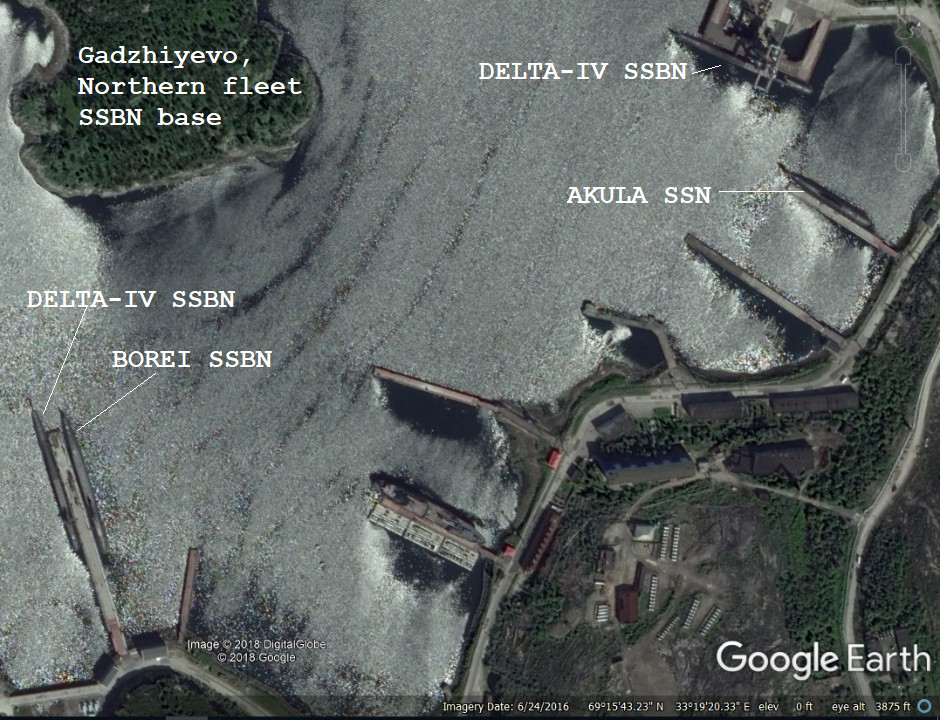
- 21st May 2016 – 4 x DELTA-IV, 1 x BOREI
- 24th June 2016 – 3 x DELTA-IV
- 22nd August 2016 – 3 x DELTA-IV
- 10th September 2016 – 2 x DELTA-IV
- 2nd October 2016 – 4 x DELTA-IV
- 30th March 2017 – 2 x DELTA-IV, 1 x BOREI
- 10th August 2017 – 1 x DELTA-IV
- 7th September 2017 – 3 x DELTA-IV
Vilkovo, Kamchatka, Pacific fleet SSBN base now with 1 x DELTA-III and 2 x BOREI
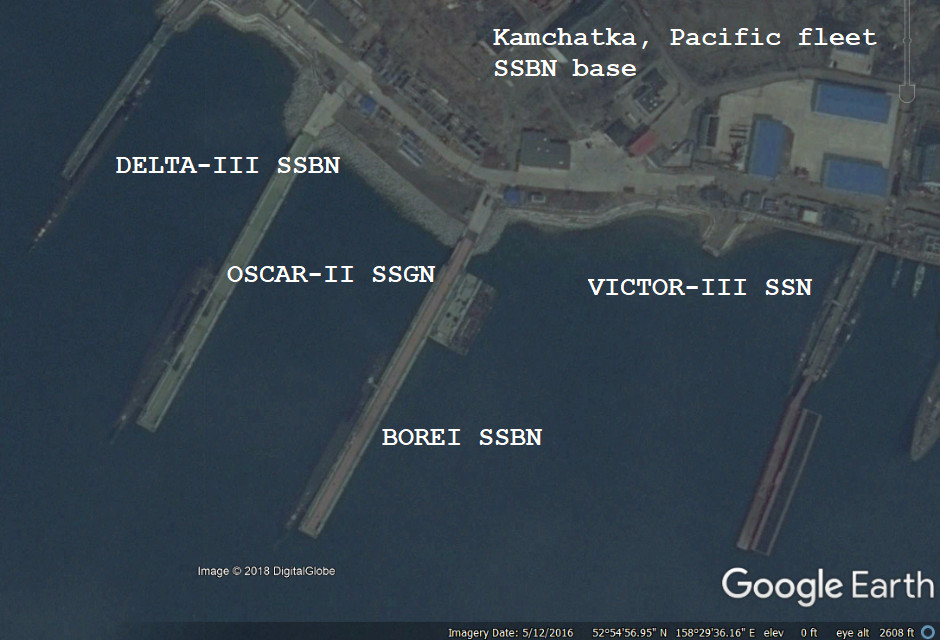
- 12th May 2016 – 1 x DELTA-III, 1 x BOREI
- 10th June 2016 – 1 x DELTA-III
- 16th June 2016 – 1 x DELTA-III
- 19th June 2016 – 1 x DELTA-III
- 25th July 2016 – 2 x DELTA-III, 1 x BOREI
- 18th August 2016 – 2 x DELTA-III, 1 x BOREI
- 31st August 2016 - 2 x DELTA-III, 1 x BOREI
- 27th September 2016 - 2 x DELTA-III, 2 x BOREI
- 30th October 2016 - 2 x DELTA-III, 1 x BOREI
- 6th March 2017- 3 x DELTA-III
- 9th June 2017- 3 x DELTA-III
- 25th June 2017 – 2 x DELTA-III, 1 x BOREI
- 2nd September 2017 – 2 x DELTA-III
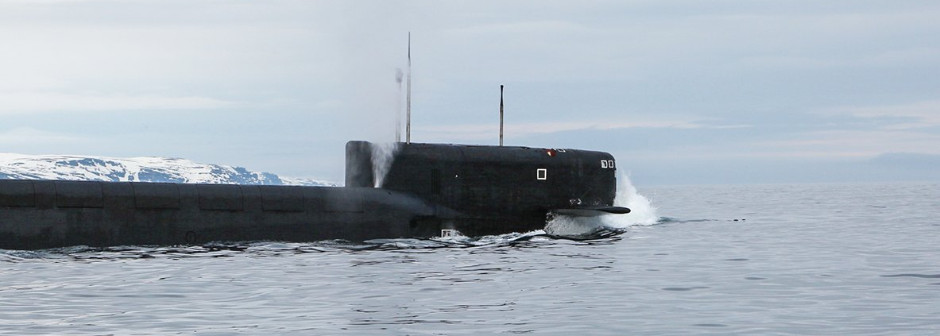
Related articles (Full index of popular Covert Shores articles)

 HUSKY Class future attack submarine
HUSKY Class future attack submarine

 BS-64 Podmoskovye Special Mission (spy) Host Submarine
BS-64 Podmoskovye Special Mission (spy) Host Submarine

 Project 09852 Belgorod Special Mission submarine (spy sub). w/Cutaway
Project 09852 Belgorod Special Mission submarine (spy sub). w/Cutaway

 Harpsichord AUV
Harpsichord AUV

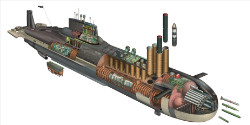 TYPHOON Class SSBN. w/Cutaway
TYPHOON Class SSBN. w/Cutaway

 Poseidon Intercontinental Nuclear-Powered Nuclear-Armed Autonomous Torpedo
Poseidon Intercontinental Nuclear-Powered Nuclear-Armed Autonomous Torpedo




 +
+ 



 Nuclear Missile submarines
Nuclear Missile submarines















 World survey of AIP submarines
World survey of AIP submarines

 SIERRA-I Class SSN
SIERRA-I Class SSN

 SIERRA-II Class SSN
SIERRA-II Class SSN

 Russian Losharik spy sub
Russian Losharik spy sub

 Russian Seismic Survey sub
Russian Seismic Survey sub

 Yantar spy ship loitering over undersea cables
Yantar spy ship loitering over undersea cables
 Russia seeks submarine advantage in Arctic (HARMONY system, GUGI special mission subs)
Russia seeks submarine advantage in Arctic (HARMONY system, GUGI special mission subs)



